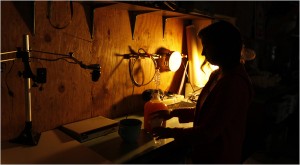
Having already pointed out the fermented tea kombucha “living” on top of the fridge, and the kefir milk fermenting in the pantry, and the homemade sourdough crackers browning in the oven, Melinda Stone led a visitor down to the basement of the Victorian house she shares with three other creative 40-somethings in the Duboce Triangle neighborhood of San Francisco. “There’s a lot of stuff bubbling down here,” she said enthusiastically, sliding open a door. “I think it’s beautiful.”
livepage.apple.comSure enough, in a corner of the dark room, five glass jugs filled with hard apple cider silently burped and fizzed. Ms. Stone (who is a part-time farmer; she and her husband own a 21-acre solar- and wind-powered farm in Humboldt County) uncorked the air lock and added some honey water, to keep the fermentation going and increase the alcohol content. “Lots of people in San Francisco make their own hooch,” she said. “Alcohol is often the gateway to urban homesteading.”
In cities across the country, the term “homesteading” has taken on a new meaning. In the late 19th and early 20th centuries, it referred to settlers occupying land, cultivating it and claiming it as their own.
Today in the Bay Area and beyond, urban homesteaders like Ms. Stone and her roommates are raising their own food in their backyards, in community gardens and on derelict and undeveloped spaces in the city. They’re preserving and pickling vegetables and fruits, sewing their own clothes, baking bread, making alcoholic beverages, and much more.
As the movement has flourished and become more mainstream — embraced by activists and food lovers alike — so too have the resources for would-be urban homesteaders.
The husband-and-wife authors Erik Knutsen and Kelly Coyne, inspired by their adventures in their Los Angeles kitchen and garden, published “The Urban Homestead,” the contemporary bible on the subject. This fall, they’ll have “Making It: Radical Home-Ec For a Post-Consumer World” (Rodale), a step-by-step book that covers everything from building a chicken coop to cooking from scratch.
For those eager to pick up (or polish) some homesteading skills, the Bay Area now teems with accessible, affordable classes and workshops.
At the three-month-old Hayes Valley Farm, which is located on a former freeway ramp in the heart of San Francisco, you can practice planting a vegetable garden and learn about seed-saving (hayesvalleyfarm.com). Up in Napa, Taylor Boetticher, an owner of the Fatted Calf charcuterie, leads four-hour salumi and whole-hog butchery workshops, as well as occasional offal-themed “blood and guts” classes, where participants create pâté, pickled pork tongues and blood sausage (fattedcalf.com).
Happy Girl Kitchen’s monthly canning workshops, which are held in Oakland and also on a farm in the Santa Cruz mountains, focus on pickling, fermenting and jam- and jelly-making (happygirlkitchen.com). At the Institute for Urban Homesteading in Oakland, the founder, K. Ruby Blume, and other instructors teach roughly 50 classes a year, on subjects ranging from cheesemaking to “urban rabbitry” and animal husbandry (iuhoakland.com).
And the chef Nicole LoBue teaches monthly four-hour “Self-Sufficient Kitchen” classes that are held at the Studio for Urban Projects in San Francisco. Planned lessons cover naturally leavened bread and fermented foods like kimchi and sauerkraut (studioforurbanprojects.org).
Homesteaders who have mastered their skills can register to sell their wares at the SF Underground Market, which pops up in a different location every month. Conceived as a way to connect consumers with home cooks and small-scale purveyors and build a sense of community, the most recent market, held in a SoMa gallery last week, attracted 2,000 attendees and 70 vendors, hawking homemade items like peanut brittle and grass-fed beef jerky.
The first market, held in December, had 150 attendees and 8 vendors. Since the vendors don’t have commercial kitchens or business licenses, attendees comply with health department regulations by signing up online as “club members” before the event (foragesf.com/market).
To further empower and inspire people, Ms. Stone, an associate professor of media studies and environmental studies at the University of San Francisco, works with fellow filmmakers and students to create quirky how-to videos that she then posts to her experimental Web site, howtohomestead.org.
On April 29 at Southern Exposure, a San Francisco arts organization and gallery, she’ll premiere films geared toward homestead newbies, including “The Elixir of Life” (about making alcoholic apple cider) and “What I Learned the Year I Made My Own Linen Underwear.” The screenings will be followed with tastings, live music and a square-dance party.
Todd Champagne, an owner of Happy Girl Kitchen, said homesteading is more than a passing trend.
“I joke at my workshops, ‘Canning is the new knitting,’ ” he said. “Food security takes on a heightened importance during difficult times.”
But he is optimistic that the cultural shift will outlast the economic downturn.
“There’s an enduring quality to these skills,” he said. “Once you get a taste of your own pickles, it’s hard to go back.”
